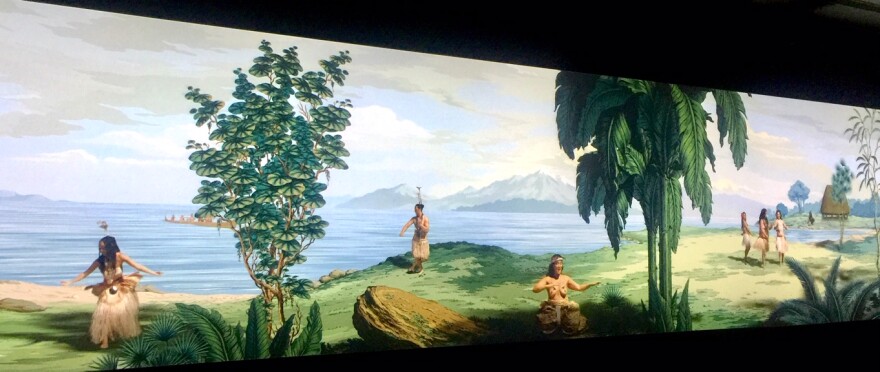Honolulu is having an art moment, with fine international artworks on view around town. For example, the Sunday Times UK called Lisa Reihana’s “Emissaries” the best artwork at the 2017 Venice Biennale. The work, representing New Zealand, left Venice with accolades and bookings in Paris, London, Vienna, and guess what? “Emissaries” is now in Honolulu in a particularly revealing installation.

“Emissaries” an installation featuring the video, In Pursuit of Venus (Infected) by Lisa Reihana continues through July 14, 2019 at the Honolulu Museum of Art.
Reihana: To show this work here, at the Honolulu Art Museum is really amazing because it’s the first time the video and the wallpaper are sitting pretty much alongside each other.
Reihana uses animation and video to bring that 19th century wallpaper to life. Thirty-five feet long, full color, the wallpaper depicts a visual tour of Pacific places and inhabitants as they seemed at first contact by Captain James Cook, The designer, Jean-Gabriel Charvet, used images from Cook’s travels for the 20 panels that make up the scene. You see palm-ish trees, and off white people cavorting like nymphs, with a volcano in the distance. It’s essentially a neoclassical depiction of an exotic utopia.

Reihana says the fact that the illustrator Charvet used for the landscape had been to Guadalupe, but not to the Pacific, accounts for the slightly odd vegetation. Reihana admits she could, of course, have “corrected” the scene, but chose to maintain a tighter connection with the source material, pulling the viewer backward in time while simultaneously presenting a contemporary, Pacific response.
Reihana: Even though it’s a kooky thing, it is absolutely beautiful and it was a technological feat of its time. I used the original structure of the wallpaper in a way that allows me to invite people into it. It sort of feels slightly off. Whether they’re on the western side or on the indigenous perspective.
Entering a dark room, Reihana’s scene unfolds along 60 feet of wall with the same sort of sepia-tinted feeling you have looking at the wallpaper. There are similar plants, the same ocean with islands beyond, and several grassy areas where people casually, seemingly unaware of each other, are going about their lives.
Reihana: There is this exoticization of indigenous people. You can see that in the way Hawai‘i is old as an image overseas. I wanted to resist that feeling of consumption. It’s almost like people are enacting culture for their own pleasure, not to be sold.
We see a wedding, two floggings, a dance rehearsal, just people meeting up. Hawaiian Chief Kalani?pu‘u is among the indigenous characters represented, as is Captain Cook and other men from the ships. In a scene Reihana calls one of her favorites, a group of women sit weaving baskets, as one makes a possum skin cloak.
Reihana: That was a resistance to the feeling that you can take your culture away. That we are still alive, we are here. The women I work with, they are not actors, they are actually weavers, they’re a weaving group that come from the original tribe in Australia I said to them if you’re not in it, again, it’s like an absence. There’s no voice. You just need to do what you do, and that’s to be seen to be practicing culture. You’ve held on to it.
Reihana: It’s a very, very minimal scene, which is one of the things I like about it. Just quietly, things are happening. It’s like life.
Life in the Pacific in the 1800's. Eighty vignettes, unfold sequentially and concurrently, over 60 minutes. You can turn the corner for the original wallpaper, Les Sauvages de la Mer Pacifique, created by French manufacturer Joseph Dufour based on designs by Jean-Gabriel Charvet. Charvet could not have known, in 1805, how his vision of the Pacific would resonate in 2019.




